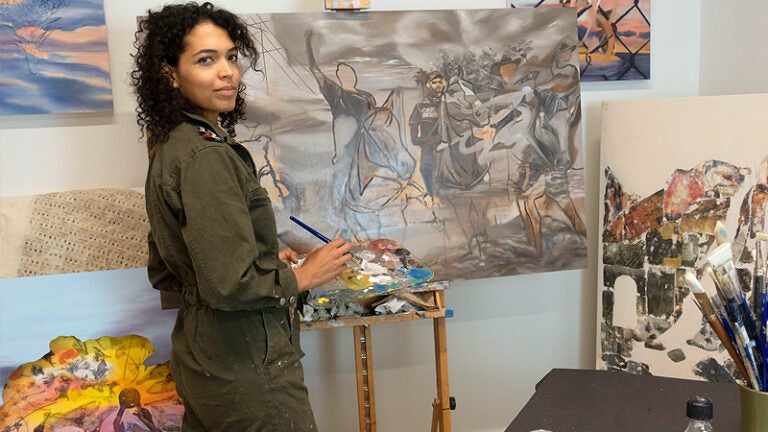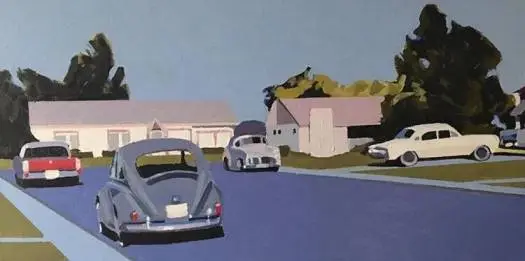American craftsman, Jessica Brilli, acquired her BFA in painting at the College of Rhode Island and got a declaration in visual depiction from the Massachusetts School of Workmanship and Plan in Boston. After very nearly 20 years working at Harvard College as a visual planner, in 2021, Brilli chose to turn into a craftsman full-time and has since collected huge acknowledgment for her work.
Her style is suggestive of twentieth century American Authenticity and visual communication, portraying pioneer lines and American iconography from the 50s, 60s and 70s. Uncovering magnificence in the ordinary, her subjects will generally be structures, objects, vehicles, pools and now and again individuals, unexceptional characters who populate the scenes like piece of the scene.

Brilli's work is about rural life, repeating her experience growing up in the North East of the US, in Lengthy Island. Uncertain in area, the artworks permit the watcher to embed themselves in the account, permuting these recollections to their own.
Having resounded with Edward Container's work since early on, her work is intensely impacted by his single metropolitan scenes, saturating the two specialists' work with a sensation of contemplative sentiment.
Related Article: Unveiling the Boulder Museum of Contemporary Art
Brilli's training depends on visual slides the craftsman finds in secondhand stores shops, yard deals and secondhand shops, skimming through thousands until one addresses her own story. Her variety range copies the normal corruption of film, concealing the first tones in yellow and earthy colored suggestions. The craftsman intends to investigate the impacts of variety on our aggregate memory.
Jessica Brilli's work has been remembered for different distributions and displayed in both physical and online scenes, across the US and globally. In 2021, the craftsman was granted a famous Pollock-Krasner Establishment Award and displayed interestingly with the exhibition in 2023.
Artist Statement
My latest assemblage of work was motivated by 35mm Kodachrome slides and ages old photos that were accumulated from areas across the US. Through my experience of painting and sharing these photographs.
I have observed that there is an innate thing in them that addresses numerous Americans, whether it be a photograph taken at a pool party in 1965 or of somebody's mom remaining before the family vehicle we embed our own lives into these scenes from an earlier time.

I view huge number of slides and photographs to genuinely track down the ones that move me. I'm continually on the chase after photographs that reflect scenes from my life as a youngster, or that I feel an association with through private or familial experience.
The rural scenes I paint mirror my own young life in New York on Lengthy Island. The vehicles gladly showed on carports, the fastidiously manicured yards, welcoming neighbor's pools, and 1960's engineering were the scenery of my childhood. However I don't live in this setting any longer, I actually feel a critical association with it.
This course of visual examination, and painting the fundamental beautiful parts, is extremely private. I've understood, nonetheless, that my encounters are essential for a consistent idea that numerous Americans share paying little mind to mature, race and orientation. The pictures that produce a surge of compulsory recollections for me frequently bring out comparable fountains of sentiments and considerations in others. Why would that be?

One more point I'm keen on investigating is the impact of variety on memory. While taking a gander at rare photography, I see the variety as an underlying time stamp. Various sorts of film age in different ways due to shaky variety colors the blurred variety conspire adds a Gestalt impact that brings out these nostalgic sentiments.
A large portion of my compositions occur in the past before I was conceived. The photos that rouse me go about as my window to the past, and in my own case these photographs variety my impression of the past. Through these canvases I'm drawing in with the past, and bringing along the watcher for the ride.
Frequently Asked Questions!
What is nostalgic painting?
Works of art reviewing recollections and implications from the past in a manner that may be excruciating the term wistfulness is gotten from the Greek words for "return" and "languishing". eighteenth and nineteenth century Heartfelt scene painters like J.M.W.
What media does Johnson Tsang use?
Brought into the world in Hong Kong in 1960, craftsman Johnson Tsang utilizes pragmatist sculptural strategies joined by his amazing surrealist creative mind. Gaining practical experience in earthenware production, hardened steel model and public work of art, Tsang pushes the limits of the watcher's creative mind.
What is nostalgia in photography?
As per the Merriam-Webster word reference, wistfulness brings out "a thoughtful or exorbitantly wistful longing for a re-visitation of or of some previous period." In photography, we can utilize sentimentality or the impact of wistfulness as an incredible asset to add profound effect.
What media did Nam June Paik use?
Paik began to play with the most recent devices and was quite possibly the earliest craftsman to utilize television and video. He assembled television robots, television walls, made his own synthesizer and communicated real time occasions. His notable work showed the conceivable outcomes of video in craftsmanship and made ready for future specialists.
What are the two types of nostalgia?
Sentimentality can be partitioned into two classifications: verifiable wistfulness and individual sentimentality. This type happens when an individual pines for a period or society that might originate before their own reality.







